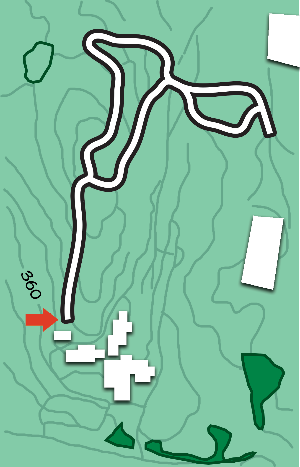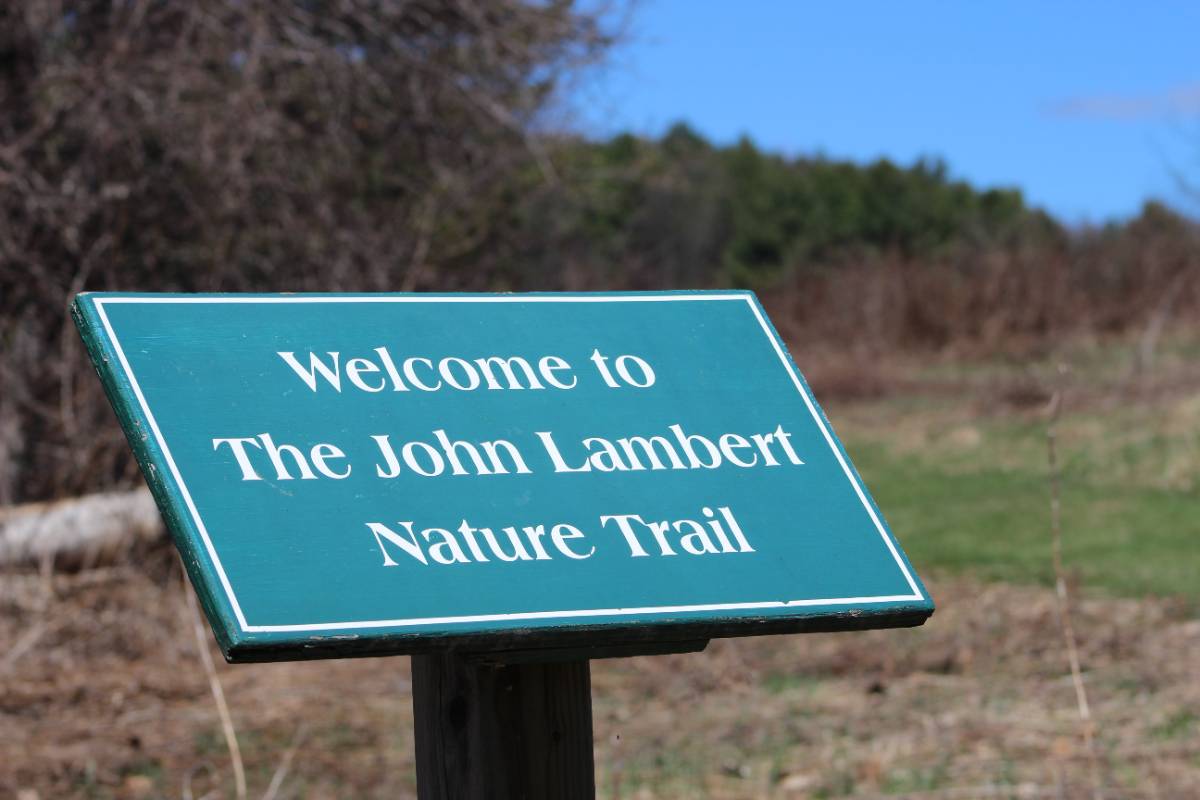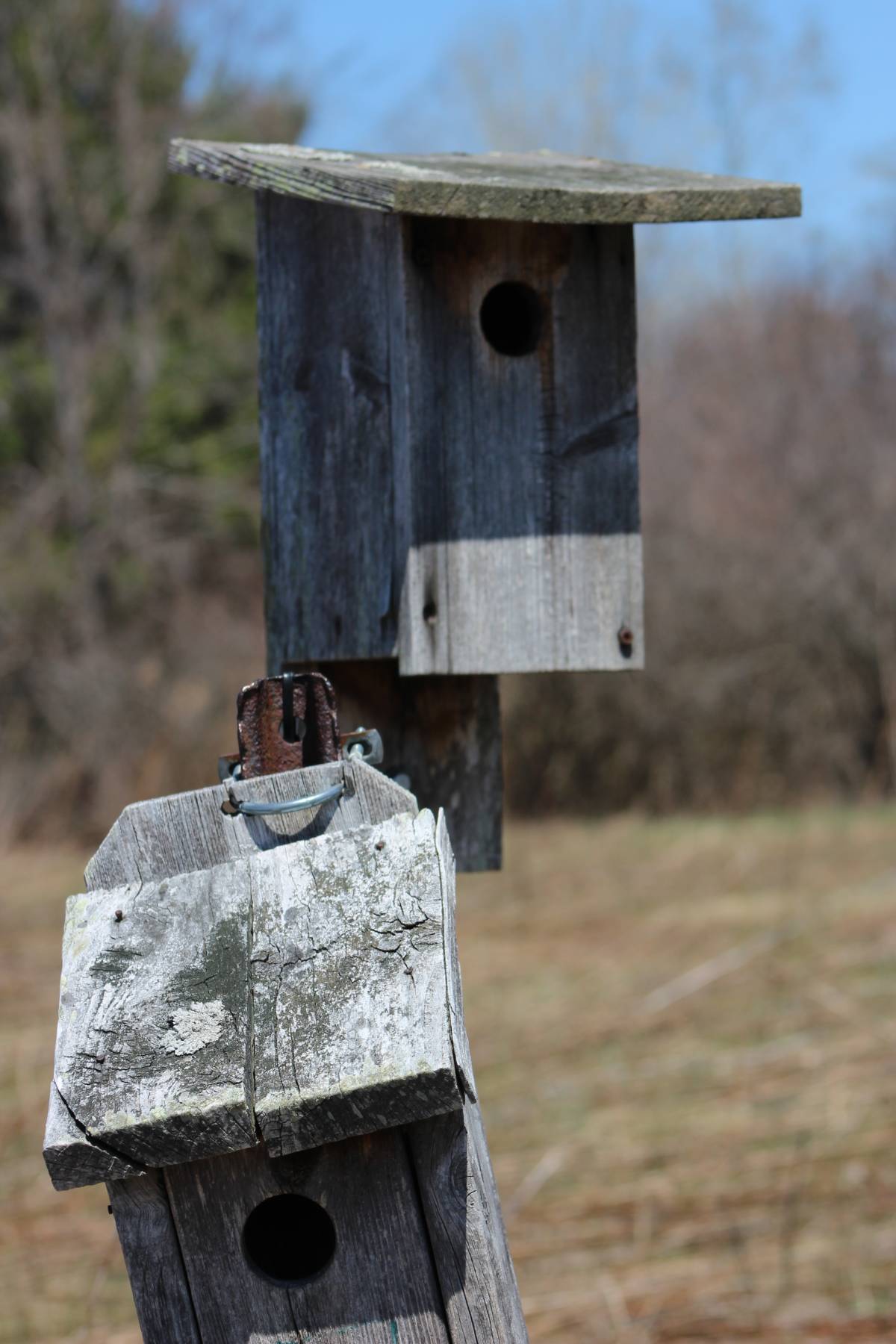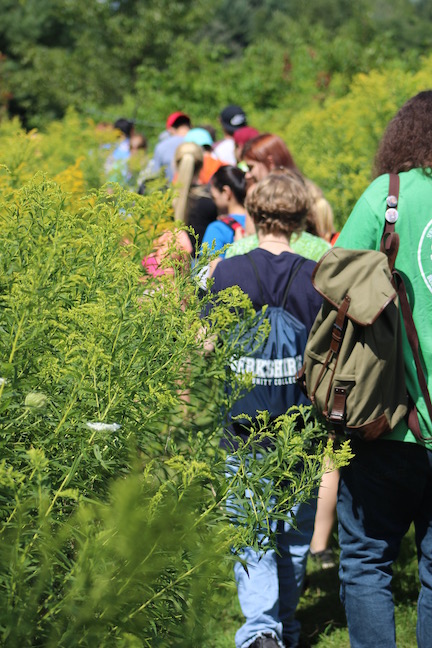Nature Trail Self Guided Tour
Start of TrailNumbered posts on the trail correspond to numbers on the map and in this guide to indicate points of natural significance. Use your right or left keyboard arrows to navigate to the next location on the self-guided tour. In different seasons there will be many areas where a person walking slowly and attentively can see, hear, smell and touch a great diversity of natural wonders. John LambertProfessor Emeritus of Sciences and Engineering. John Lambert is a highly respected former BCC professor, colleague and Dean. He was a cornerstone for Berkshire Community College’s environmental program since 1970. |
 |
 |
|
Eastern BluebirdThese boxes are set out to encourage nesting by Eastern Bluebirds and Tree Swallows. Once common here, bluebirds are considered to be a sign of spring. However, due to competition with other cavity nesters such as Starlings and House Sparrows, their numbers have greatly declined. The male bluebird’s breast and throat are earthy red and its belly is white. The rest is solid blue. Tree Swallows are all blue on top, and all white underneath. |
 |
 |
|
American KestrelThis nest box was placed high above the ground for a small falcon known as the American Kestrel, formerly called the Sparrow Hawk. This raptor (bird of prey) is about 26cm long with a wing span of about 53cm. It is identified by its russet back and tail, and two black stripes on its white face. The male has blue-gray wings and is smaller than the female. This bird is found not only in the country, but also in cities usually perched on telephone wires. Kestrels feed on small mammals, reptiles, insects and small birds. |
 |
Old Field SuccessionYearly mowing prevents the reappearance of shrubs and saplings in this field, and provides prime habitat for redbelly snake, monarch butterflies, meadow vole, eastern cottontail and other wildlife that favor open habitat. If this land were not mowed, it would succeed from grasses to shrubby growth, which would be replaced by rapid-growing trees such as Cherry, White Pine and Aspen. After many years, this abandoned cropland might support a forest of Maple, Oak and Pine. Ecological succession is one community of organisms replacing another over time. |
 |
 |
|
MountainsTake a moment to follow the horizon from the right to left. The Taconic Range to the west and the beautiful Berkshire Hills behind you provide protection to the valley below. Complex geologic events over long periods of time formed these mountains. For example, the Taconic Range formed from a volcanic island arc, similar to that found in Japan, and was later modified by the tectonic collision that produced the Appalachian Mountains. |
 |
 |
|
Soil Formation and Parent MaterialApproximately 15,000 years ago, the Wisconsin glacier completely covered this part of New England up to 10,000 feet thick! The land below it was mostly rock. The soil beneath your feet developed in large part from the physical disintegration and chemical decomposition of parent rock seen here in this ledge. Repeated freezing and thawing causes “wedging.” This and other examples of weathering give rise to soil particles – sand, silt and clay. Organisms such as lichens break particles down further; these and decaying plant materials contribute to the formation of humus. What we think of as “dirt” is really a living combination of mineral particles, decayed vegetation, water, air and organisms such as moles, worms, insect larva and bacteria. |
 |
Tip UpStorm winds blew over this white pine. However, a shallow root system contributed to its fall — notice the shallow soil layer and the rocks exposed underneath the root system. Good soil structure is important for the development of a strong root system. |
 |
Birch TreeBirch bark may be white, gray, silver, or black depending on its species. Each displays the distinctive bark pattern of horizontal marks. From the White Birch (also called Canoe Birch), Native Americans cut bark to cover canoes and wigwams. The aromatic bark of the Black and Yellow Birch contains oil that smells of wintergreen. The sap of other species can be used to produce a sweet syrup and once served as the raw material for birch beer. |
 |
White PineYou are in a stand of White Pines about 75 years old. Often the first tree to appear in abandoned fields, the rapidly growing White Pine is widely cut in New England for lumber. Sometime in the future, these trees will be succeeded by other trees such as Maples and Ashes. An easy way to tell a White Pine from a Red Pine is that a White Pine has five needles in a cluster, and a Red Pine has three needles in each cluster. |
 |
LightningLightning struck this tree on August 23, 1996. Notice the large chunks of wood exploded out of the trunk by the force of more than 100 million volts. Trees normally survive direct hits because the bolt’s energy travels over their surfaces. When the energy passes through the tree, as occurred here, it literally blows it apart when the water in the tree vaporizes and expands. |
 |
FernsMoisture and shade loving perennials, ferns are one of the oldest types of plants. They originated about 350 million years ago when ferns once dominated the earth’s vegetation. Giant tree ferns as tall as 40 feet flourished, and the energy they gathered from the sun and stored in their tissues remain as the earth’s diminishing coal deposits. |
 |
Pit and MoundThe ground here illustrates a pit and mound pattern caused by Tip Ups in years past. The severe hurricane of 1938 downed many of the tall trees that stood here. When you approach the wood road, follow the arrow back up the hill, unless you want to cross the road and explore the wetland loop (orange blazes). On the loop you can see distinctive wetland vegetation and the source of a brook, among other things. |
 |
Forest GapA forest gap occurs when a large tree falls. With the opening in the canopy, sunlight on the forest floor allows young trees to thrive. Other species that require more light, such as blackberries, may spring up, bringing more biological diversity to the forest. |
 |
Striped MapleThe Striped Maple is also called “Moosewood” because moose eat the bark and buds, as do beavers, rabbits and deer, especially in winter. Easily recognized in all seasons by its green and white striped bark, the Striped Maple seldom grows much bigger than this. Typically an understory tree in northern hardwood forests, note that its large leaves are an adaptation for dealing with less light. |
 |
Forest CommunityThe trail is passing from one forest community to another. Behind you is a stand of pines and hardwoods (broad leafed trees such as the Sugar Maple). Ahead is a White Pine Community. Note the lack of plants on the ground. Pine needles form a thick mat that decays slowly and is very acidic. This shaded environment discourages the growth of other plants on the forest floor. |
 |
EcotonePassing into the open meadow, you find yourself in an Ecotone, or transition area, between two types of communities. Many animals thrive on the diversity of plants that grow in Ecotones. Deer graze on grasses in the meadow and can still be close to the shelter of the forest. Birds can rest in branches and survey a large area for things to eat; as they do so, they drop undigested seeds from the fruit they have eaten. For this reason, New England Ecotones often have species of plants that produce edible fruits like raspberries, elderberries and chokecherries. |
 |
